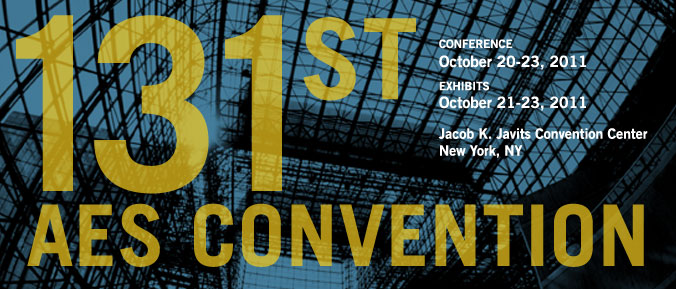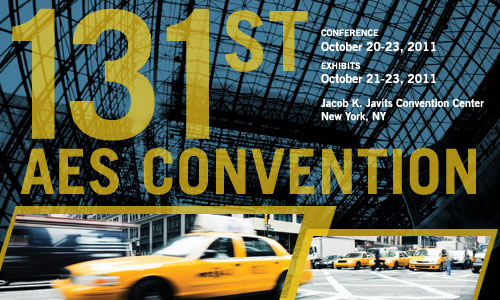
AES New York 2011
Poster Session P24
P24 - Spatial Audio Processing—Part 2
Sunday, October 23, 2:30 pm — 4:00 pm (Room: 1E Foyer)
P24-1 A Selection Model Based on Perceptual and Statistics Characteristic for Interaural Level Difference—Heng Wang, Ruimin Hu, Weiping Tu, Ge Gao, Wuhan University - Wuhan, Hubei, China
In present mobile communication systems, a low bit rate audio signal is supposed to be provided with high quality. This paper researches the mechanism that exists of perceptual and statistics redundancy in binaural cues and establishes a selection model by joint perceptual and statistics characteristic of ILD. It does not quantize the values of ILD where the frequency bands can’t easily be perceived by human ears according to the selection model. Experimental results showed that this method can bring down the parametric bit rate by about 15% compared with parametric stereo, while maintaining the subjective sound quality.
Convention Paper 8574 (Purchase now)
P24-2 Perceptual Evaluation of a Spatial Audio Algorithm Based on Wave Field Synthesis Using a Reduced Number of Loudspeakers—Frank Melchior, Udo Heusinger, IOSONO GmbH - Erfurt, Germany; Judith Liebetrau, Technical University Ilmenau - Ilmenau, Germany
With 3-D picture being the driving force of today’s motion picture production, there is a growing need for adequate audio solutions, e.g., spatial audio algorithms for reproduction with flexible loudspeaker setups. While these reproduction systems will have to fulfill high quality demands, the amount of loudspeakers needed should be kept as low as possible to optimize commercial aspects. One suitable algorithm from a quality point of view is wave field synthesis (WFS), which, however, requires a huge amount of speakers if implemented as stated in literature. This paper presents the results of a perceptual evaluation of a new algorithm based on WFS. A listening experiment compared state-of-the-art WFS, the new algorithm, and Vector Base Amplitude Panning regarding their perceived localization and coloration.
Convention Paper 8575 (Purchase now)
P24-3 Design and Evaluation of an Interactive Simulated Reverberant Environment—Alan C. Johnson, Kevin Salchert, Andreas Sprotte-Hansen, New York University - New York, NY, USA
There are many existing approaches to the challenge of simulating a reverberant field. Most of these methods are designed to operate on a signal that has been recorded in a relatively anechoic environment and seek to add in the simulated reverberation of a chosen space. This paper describes a low-cost, scalable approach for directly converting an acoustically dry space into a reverberant space of a larger size, with a number of configurable parameters. This is accomplished by harnessing the mutual feedback among microphones and loudspeakers arranged in the space. The result is a simple, tunable, and interactive system for creating a convincing reverberant environment. Several novel applications of such a system are also discussed.
Convention Paper 8576 (Purchase now)
P24-4 Multi-Touch Room Expansion Controller for Real-Time Acoustic Gestures—Andrew Madden, Pia Blumental, Areti Andreopoulou, Braxton Boren, Shengfeng Hu, Zhengshan Shi, Agnieszka Roginska, New York University - New York, NY, USA
This paper describes an application that provides real-time high accuracy room acoustics simulation. Using a multi-touch interface, the user can easily manipulate the dimensions of a virtual space while hearing the room’s acoustics change in real-time. Such an interface enables a more fluid and intuitive control of our application, which better lends itself to expressive artistic gestures for use in such activities as sound design, performance, and education. The system relies on high accuracy room impulse responses from CATT-Acoustic and real-time audio processing through Max/MSP and provides holistic control of a spatial environment rather than applying generic reverberation via individual acoustic parameters (i.e., early reflections, RT60, etc.). Such an interface has the capability to create a more realistic effect without compromising flexibility of use.
Convention Paper 8577 (Purchase now)
P24-5 Adaptive Crosstalk Cancellation Using Common Acoustical Pole and Zero (CAPZ) Model—Common Pole Estimation—Hanwook Chung, Seoul National University - Seoul, Korea; Sang Bae Chon, Samsung Electronics Co. Ltd. - Suwon, Gyeonggido, Korea; Nara Hahn, Koeng-Mo Sung, Seoul National University - Seoul, Korea
In this paper we introduce adaptive crosstalk cancellation using a common acoustical pole and zero (CAPZ) model for a head-related transfer function (HRTF). As the CAPZ model for HRTF provides an interpretation of the HRTF wherein zeros describe the spatial difference caused by the acoustical propagation path and common poles describe the characteristics of the human auditory system, we designed the proposed model to follow the zero components of the CAPZ model. By estimating common poles and simulations, we verified that the proposed model exhibits enhanced performance compared with a conventional finite impulse response model of HRTF.
Convention Paper 8578 (Purchase now)
Information Last Updated: 20111005, mei

